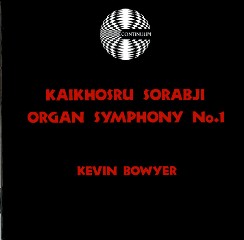Kaikhosru Shapurji Sorabji - Organ Symphony No. 1 (1993)
Kaikhosru Shapurji Sorabji - Organ Symphony No. 1 (1993)

1 First Movement: Prelude. Passacaglia. Postlude 34:35 2 Second Movement: Introduction. Fugue. Code 36:25 3 Third Movement 46:53 Kevin Bowyer - organ
Kaikhosru Shapurji Sorabji (1892-1988) was a British-born composer of Parsi and Sicilian descent. In 1936 he gave his last public performance as a pianist, in order to concentrate on composition and music criticism, reserving all rights for performance of any of his works, and only rarely granting such rights. He was voluminously prolific, not only in quantity but sheer length of works. The present Organ Symphony (written 1923-24) is nearly two hours in length; its third (last) movement alone is 46 minutes and 55 seconds on this recording (the entire second disc)! And this is modest compared to his perhaps most (in)famous work, the Opus Clavicembalisticum for solo piano, which takes as long as 4 & 1/2 hours to perform.
Sorabji was largely self-taught as a composer, studying the works of Liszt, Busoni, Szymanovsky and several others as he developed his own distinct language. His music is often dense, often intensely contrapuntal, freely dissonant, frequently grandiose in its rhetoric.
Kevin Bowyer shared the first complete public performance of this work with Thomas Trotter shortly before this recording was made entirely by Bowyer in 1988. It uses the 4-manual, 74-rank 1911 Harrison & Harrison organ of St. Mary Redcliffe Church, Bristol, considered by some to be this firm's finest organ. Bowyer has gone on to perform this work further, as well as prepare a corrected version of the score, and produce an edition of Sorabji's (even longer!) 2nd Organ Symphony (there is also a yet longer 3rd!).
This album is a must-have for all Sorabji fans -- a rare breed of music-lover, indeed -- especially since the composer considered this to be his "earliest truly personal and mature work". It is also recommended to all interested in modern organ music; even though 1924 can now hardly be called "modern", this music still represents such a daring exploration of musical limits as to justify calling it "modern," in an important sense.
As one of the rare owners of the music's score (I was lucky to get one of the last copies before it went out of print), I have studied Bowyer's performance to some degree. The mere fact that he plays the piece at all, with any degree of accuracy, is an astonishing and enviable accomplishment. The complexity of the music (notated on four staves throughtout rather than the usual three) defies description, often sounding as if more than one person is playing at once. Furthermore, the technical demands are virtuosic in the extreme, not only as to velocity of notes, rhythmic complexity, but in the unthinkable demands on concentration and stamina required by the monstrous length of the work.
As to the album's presentation, I wish that the timings were given on the booklet or on the discs, and also that sections of the huge movements were individually cueable; the fact that the second disc consists of one immense band makes it very cumbersome to handle, especially for study purposes.
Even so, I rate this recording highly simply because it is the only recording available of a true monument of organ repertoire, and as such deserves appropriate recognition. --- Rodney Molnar-Pohdap, amazon.com
download (mp3 @320 kbs):
yandex mediafire ulozto cloudmailru
Last Updated (Tuesday, 24 July 2018 11:53)








